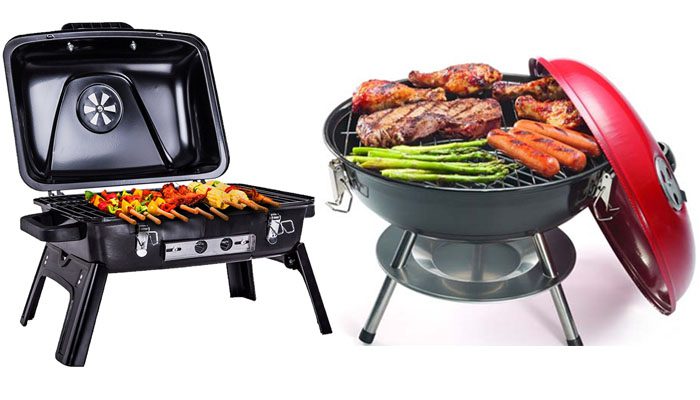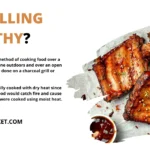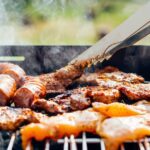
Imagine you’re standing in your backyard, surrounded by the tantalizing aroma of sizzling burgers and juicy steaks. The sun is shining, friends are gathered around, and the only question on everyone’s mind is, “Which grill is safer – propane or charcoal?”
It’s a common debate among grill enthusiasts, and in this article, we’ll take a closer look at the safety aspects of both options. So grab your apron and get ready to fire up the grill, because we’re about to uncover the answer to this sizzling hot question!

This image is property of www.thelowcarbgrocery.com.
Propane Grills Overview

Propane grills have gained popularity among grill enthusiasts due to their convenience and ease of use. These grills, also known as gas grills, use propane gas as the main fuel source. Propane is a highly flammable gas that is stored in propane tanks, which are connected to the grill through a hose and regulator. When the grill is ignited, the propane gas is released and ignited to produce heat.
How They Work
Propane grills operate by utilizing a pressure regulator to control the flow of gas from the propane tank to the burners. The burners, typically made of stainless steel or cast iron, distribute the heat evenly across the cooking surface. The temperature can be adjusted by manipulating the control knobs, allowing you to achieve the desired level of heat for grilling.
Safety Features
Propane grills are equipped with various safety features to ensure a secure grilling experience. One essential safety feature is the automatic ignition system, which creates a spark to ignite the propane gas when the control knob is turned on. This eliminates the need for matches or lighters, reducing the risk of accidents.
Additionally, most propane grills have a built-in flame failure device, commonly known as a thermocouple. This device detects whether the flame is present or not. If the flame goes out, the thermocouple automatically shuts off the flow of propane gas, preventing a potentially hazardous gas leak.
Potential Risks
While propane grills are generally safe to use, there are a few potential risks to be aware of. One of the main risks is carbon monoxide (CO) exposure. Propane grills produce carbon monoxide during combustion, which is a colorless and odorless gas. It is crucial to use propane grills in well-ventilated areas to help prevent the build-up of carbon monoxide. Grilling in enclosed spaces, such as garages or tents, can lead to the accumulation of carbon monoxide and pose a health risk.
Leak risks are another concern when using propane grills. Leaking propane gas can result in fire or explosion hazards, posing a significant danger to both you and your property. Regularly inspecting the propane tank and connections for any signs of damage or wear is crucial.
It is recommended to perform a simple leak test before each use by applying a solution of soap and water to the connections. If bubbles form, it indicates a leak, and the grill should not be used until the issue is resolved.
Tipping hazards are also worth considering. Propane grills can be heavy and have a higher center of gravity, making them susceptible to tipping over if not properly stabilized. Always ensure that the grill is placed on a stable and level surface, and consider using wheel locks or latches to prevent movement during use.
Regulatory Standards
Propane grills are subject to specific regulatory standards to ensure their safety. These standards cover various aspects, including design, construction materials, heat output, and performance. Grill manufacturers must adhere to these standards to ensure their products meet the necessary safety requirements.
Look for grills that are certified by reputable testing organizations, such as the Canadian Standards Association (CSA) or the Underwriters Laboratories (UL), to ensure compliance with these standards.
Tips for Safe Use
To ensure the safe usage of propane grills:
- Always read and follow the manufacturer’s instructions and safety guidelines.
- Use propane grills outdoors in well-ventilated areas, away from flammable materials and structures.
- Regularly inspect the propane tank and hoses for any signs of damage or wear.
- Perform a leak test before each use using a solution of soap and water.
- Store propane tanks in a well-ventilated, upright position away from heat sources.
- Keep a fire extinguisher nearby when grilling as a precautionary measure.
- Never leave a lit propane grill unattended.
Conclusion
Propane grills offer a convenient and efficient way to enjoy outdoor cooking. While they come with inherent risks such as carbon monoxide exposure, leak hazards, and tipping hazards, these risks can be minimized through proper usage and regular maintenance. By following safety guidelines and conducting routine checks, you can safely enjoy the delicious flavors of grilled food with peace of mind.
Charcoal Grills Overview

Charcoal grills have a long-standing tradition in the world of outdoor cooking. These grills utilize charcoal briquettes or lump charcoal as the primary fuel source. Charcoal is made from wood that has been heated in the absence of oxygen, resulting in the formation of carbonized wood, commonly known as charcoal. The charcoals are then placed in the grill, ignited, and used to generate heat for cooking.
How They Work
Charcoal grills function through a simple combustion process. The charcoal is arranged in a bed at the bottom of the grill, which acts as the fuel source. Once ignited, the charcoal burns slowly, releasing heat and emitting smoke. The heat generated can be regulated by adjusting the vents in the grill, allowing for precise temperature control during cooking.
Safety Features
Charcoal grills often have minimal safety features compared to propane grills. However, they typically feature a lid and a heat-resistant handle, allowing you to safely access the cooking area without the risk of burns. Additionally, some higher-end charcoal grills may have ash catchers or trays to collect the ash, preventing it from falling onto the ground and causing fire hazards.
Potential Risks
Charcoal grills have their own set of potential risks that should be taken into consideration. One of the primary risks is a fire hazard. Charcoal briquettes and lump charcoal can burn at high temperatures and may pose a fire risk if not properly handled.
It is crucial to keep a close eye on the grill while it is in use and ensure that it is placed on a non-flammable surface, away from combustible materials.
Carbon monoxide exposure can also be a concern when using charcoal grills. While propane grills produce carbon monoxide during combustion, charcoal grills produce significantly higher levels.
To prevent exposure, charcoal grills should always be used in well-ventilated areas, such as open spaces or outdoor settings.
Burn risks are another consideration with charcoal grills. The high temperatures reached by the burning charcoal can cause severe burns if not handled with caution. It is essential to use heat-resistant gloves or tools when manipulating the charcoal or adjusting the grill during cooking.
Proper disposal of ash is crucial to avoid potential fire hazards. Charcoal ash can remain hot for several hours after grilling, and improper disposal can lead to accidental fires. Wait until the ash has cooled completely before disposing of it in a non-combustible container or designated ash disposal area.
Regulatory Standards
Charcoal grills are not subject to the same degree of regulatory standards as propane grills. However, manufacturers are generally expected to meet basic safety requirements and guidelines.
Ensure that the charcoal grill you purchase is made with high-quality materials and construction, and consider reputable brands that have a track record of producing safe and reliable products.
Tips for Safe Use
To ensure the safe usage of charcoal grills:
- Read and follow the manufacturer’s instructions and safety guidelines.
- Use charcoal grills outdoors in well-ventilated areas, away from flammable materials and structures.
- Keep a safe distance between the grill and any structures to prevent accidental fires.
- Use heat-resistant gloves or tools when handling hot charcoal or adjusting the grill.
- Dispose of ash in a non-combustible container or designated ash disposal area.
- Store charcoal in a cool, dry place to prevent moisture absorption and spontaneous combustion.
- Practice proper fire safety measures and have a fire extinguisher nearby in case of emergencies.
Conclusion
Charcoal grills provide a traditional and flavorful method of outdoor cooking. While they come with certain risks, including fire hazards, carbon monoxide exposure, burn risks, and ash disposal challenges, these risks can be mitigated with proper safety precautions and responsible usage.
By following the manufacturer’s guidelines, employing safe grilling practices, and remaining vigilant, you can enjoy the unique taste and experience of cooking with charcoal grills in a safe and enjoyable manner.




